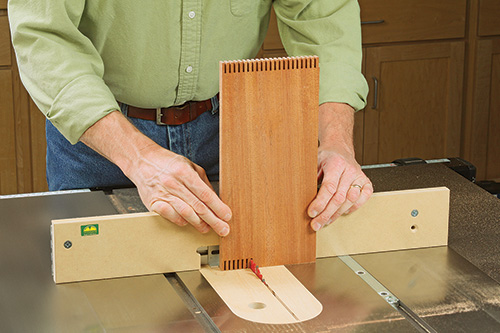
While I read many articles on table saw motors, belts, pulleys, etc., I have seen nothing concerning blade rpm. Is there an optimum general-purpose rpm for the table saw? I know on many blades a maximum of about 5,500 rpm is given. I have found no mention in my owner’s manual, and the supplier (Sears) can offer no help. I’m running a 2 HP motor at 3,450 rpm. I have a 3″ drive pulley and a 2″ pulley at the arbor. I believe this turns the blade at about 5,100 rpm. The cut is very smooth, but I would like lower noise levels. So how would decreasing the rpm affect the saw’s performance?
Ellis Walentine: Most table saws run in the 3,000 to 4,000 rpm range. You could decrease your blade rpm to 4,140 by increasing the size of the arbor pulley to 2 1/2″. It wouldn’t change your saw’s performance much. In fact, the slower speed would have less of a tendency to heat up the blade, thereby conserving carbide and cutting down any warpage that is caused by thermal expansion.
Noise levels, on the other hand, are the product of blade and gullet design. If whistle is bothering you, you might want to look into one of the “quiet” blades such as those sold by Freud and some other manufacturers. These have specially designed gullets and laser-cut expansion slots in the blade that tend to dampen vibration and deaden the whistle of a freewheeling blade. Even the quietest blades, though, are noisy when cutting, especially on harder woods, so ear protection is always recommended.
Lee Grindinger: I doubt it’s the rpm that is causing your noise. In all likelihood it’s the blade. Having used hundreds of blades, I will attest to the fact that some of them are real screamers. Gullet depth and configuration can lead to excessive noise, the tooth configuration can make for a noisy blade; and the expansion slots can contribute as well. Try a new blade by a different manufacturer. As to arbor speed, manufactures spec bearings and motors based upon blade speed and stresses. A circular saw needs to spin fast enough to true itself, but not so fast that it’s a risk to the user. Use the manufacturer’s pulley sizes or you could be placing yourself at risk.
Michael Dresdner: There’s a sizeable range of speeds that will work for a table saw. Yours is at the high end – 4,500 rpm is more typical. The biggest problem with increasing speed is that it intensifies any vibration in the blade, which usually shows up as a rougher cut in addition to more noise. However, you might also look into tightening up other noisy areas. In-line Industries sells an upgrade kit that lets you replace noisy V-belts with link belts, and swap out cast sheaves with machined ones. It will make your table saw run both smoother and quieter. You can ask for Jerry Cole, and tell him I sent you!







